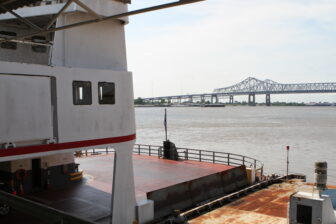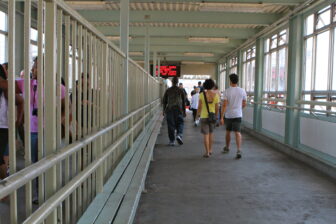Considering that the Algiers ferry has been a fixture on the river for years, its demise seemed to come suddenly. The ferry lost its main source of funding, the Crescent City Connection tolls, earlier this year. No private company stepped in to take it over. Dreams to turn it into a party boat foundered. So on July 1, service was reduced during the times some say it’s needed most.
A review of city and regional planning documents, as well as bills that never made it out of the Legislature, suggest that some officials saw the cutbacks coming but did little to successfully salvage the service. Public documents dating back to 2009 made it clear that the funding for the Algiers, Gretna and Chalmette ferries, the Crescent City Connection tolls, would expire at the end of 2012, and that they may not be extended.
“No, there was never a plan because, first of all, we never expected to lose the tolls.” — Council President Jacquelyn Clarkson
Planning documents for the last several years show a “should they stay or should they go” vacillation towards the city’s ferries. Documents outline reasons why they should be cut or saved. By and large, no one took action.
The culprit, it seems, is a division of responsibility: The agency responsible for running the ferries was a division of the state Department of Transportation and Development. It maintained the ferries but didn’t implement long-term planning. The arrangement worked fine — as long as people kept paying to drive over the river.
“No, there was never a plan because, first of all, we never expected to lose the tolls,” City Council President Jacquelyn Clarkson said.
“And secondly, every time we talked ferry boats, there was a different approach, and a different matrix of players, depending on whether you were talking one ferry boat, two ferry boats, three ferry boats. It’s all changed over the years.”
The Lens found little or no mention of ferries in these planning documents:
-
The Louisiana Statewide Transportation Plan for 2003 or 2008
-
The City of New Orleans’ “Plan For the 21st Century: New Orleans 2030,” commonly called the Master Plan
-
The Metropolitan Transportation Plan for the New Orleans Urbanized Area, Fiscal Years 2011 to 2040, created by the Regional Planning Commission
Despite the funding problems, the state decided to continue to operate the Chalmette ferry because it connects two state highways and qualified for state transportation funds. The Gretna ferry, the least-used of the three, was closed. And the Algiers ferry is treading water.
The situation, particularly with the Algiers ferry, has caused an outcry among supporters, as well as some politicians.
“It’s critically important that we stay on this, and we are,” Clarkson said.
She also sits on the Regional Planning Commission, a board of elected officials and citizens who provide transportation and economic development planning. Historically, the commission has made recommendations to the state about the ferries.
“The kid is drowning in the ocean and everybody is on the boat saying, ‘This is terrible, we should do something about this.’ But who’s going to jump in and risk their life to save him?” — Fay Faron, Friends of the Ferry
Though Clarkson says she feels strongly about saving the ferries, it wasn’t until February that she introduced a resolution creating a new Regional Planning Commission committee to plan for the short- and long-term operations of ferry service in New Orleans.
That resulted in a series of meetings with state and local officials and the Regional Transit Authority, said Jason Sappington, one of the commission’s senior transportation planners. He didn’t tell The Lens who is on the committee or when it’s met.
Also on the Planning Commission: Mayor Mitch Landrieu and Councilwoman Stacy Head. Neither responded to requests for comment.
Sappington said that the commission has assisted with fare structures and timelines for capital investments, and it has helped identify potential funding from the Federal Transit Administration.
Sappington said those discussions were partially responsible for spurring legislation by state Sen. David Heitmeier, D-New Orleans, this spring to authorize transition funding and enable RTA to take over the Algiers and Chalmette ferries.
Algiers business owners and ferry advocates say the current efforts are just too little, too late.
Fay Faron, founder of Friends of the Ferry, compared the situation to a child who can’t swim.
“The kid is drowning in the ocean and everybody is on the boat saying, ‘This is terrible, we should do something about this.’ But who’s going to jump in and risk their life to save him?”
Transportation plans include highways and bike lanes, but no ferries
Although the Regional Planning Commission says that New Orleans area ferries are critical to a healthy transportation system, they don’t appear in the commission’s Metropolitan Transportation Plan for the New Orleans Urbanized Area.
The wide-ranging document is updated at least once every four years. The latest plan on the website is dated September 2010. The document describes the Regional Planning Commission’s responsibility of “highway, transit, and transportation management,” as well as traffic congestion and air quality.

The plan discusses the need for flexible modes of transportation, outlining plans for a $45 million downtown streetcar line, a transit bus replacement program and new roadways and bikeways. But it says little about ferries.
Detailed plans for the city’s ferry services have been omitted from public plans for years.
The City Planning Commission’s “A Plan for the 21st Century,” commonly referred to as The Master Plan, acknowledges that the ferries are an important mode of transportation for commuters. The plan, however, does little to outline how the ferries should operate in the next 17 years.
In fact, it only recommends a strategy to “identify and study potential new Mississippi River ferry connections.”
That strategy, to be implemented by the Regional Planning Commission, is slated for the “medium term” — between 2015 and 2019.
In 2003, the Louisiana Department of Transportation and Development finished a new Louisiana Statewide Transportation Development Plan, with input from top elected officials in the state.
It mentions highway improvements, bridge preservation, even pavement preservation — but not ferries.
A follow-up to the plan, created in 2008, calls for ferries to get funding under a best-case scenario. Even then, the ferries would have to share funding with rest stops, bridge maintenance and other projects.
Another statewide transportation plan is being drafted. It’s slated for completion in 2014.
There is a reason ferries weren’t included. Though they were operated by a division of the Department of Transportation and Development, they weren’t part of the state highway system. A task force studying the Crescent City Connection Division wrote in February 2012: “DOTD does not provide this type of funding for ferries that are not within the State Highway System or cannot be connected to the State Highway System, such as the Gretna and Algiers ferries.”
The task force went on to say that if the tolls were to expire, capital expenditures for the ferries needed to be funded either through local government or through a privatized system.
That diffusion of responsibility continues, with the state running the remaining two ferries in the area, but the Regional Planning Commission charged with oversight of the ferries.
Sappington said the commission “recognizes the ferry service as a critical connection in the region’s transportation network,” but it “does not operate the ferries, nor does it have any direct authority over its operations.”
Studies show trouble
Meanwhile, studies conducted for the state transportation department and the Regional Planning Commission identified long-term problems with ferry funding.
In 2008, a Five Year Ridership Projection was created for the Crescent City Connection Division for ferry operations. The report ultimately said that ridership would decrease if improvements weren’t made to the ferries, such as increasing the hours for the Algiers ferry, moving the Gretna ferry to Canal Street, and updating the terminals.
In 2009, a Waterborne Public Transit Study was conducted for the Regional Planning Commission.

That study suggested that ferry plans were languishing because its funding sources were tied to legislation. It warned that tolls could expire in 2012 and suggested that the ferry be operated as a private or public-private transit operation, and that the Crescent City Connection Division seek outside revenue such as advertising in terminals and charter excursion services.
As an example, the waterborne transit study shows a picture of advertising shown on New York metropolitan area ferries for New York Harbor Midtown Cruises. Advertisements like those generate up to $10,000 per month per vessel, the study says.
“The need for making changes and addressing these impediments is to create an environment inside of which the ferry operation is more businesslike,” the study stated.
All of its suggestions relied on some sort of privatization — everything from contracting out the operation, handing everything over to a private company, or privatizing selected routes.
However, no law to authorize privatization was passed for another three years.
Two years later, the Bureau of Governmental Research made very different suggestions in a document called “Over the River: The Future of Crescent City Connection Bridge and Ferries.”
The nonprofit policy organization essentially said that there would be a couple of options after the tolls expired: Set fares for pedestrians and increase car fares to subsidize the state Transportation Trust Fund, or take the “aggressive” approach of shutting down one or more ferry lines statewide after a thorough evaluation.*
In the report, the agency strongly advocated cutting off the bridge tolls as the source of ferry funding.
“BGR’s position should not be interpreted as indifference to ferry service,” the report read. “Rather, it flows from the relative return on investment and the characteristics of revenue resources. The public gets far more bang for its buck from the bridge.”
In 2012, a task force, comprised mostly of business associations and nonprofit organizations, released a comprehensive report on the Crescent City Connection Division. Some members included representatives from Greater New Orleans, Inc., Friends of the Ferry and the Algiers Economic Development Foundation, as well as representatives from Jefferson, Plaquemines and St. Bernard parishes.
The group was divided over whether to continue to subsidize the operations with tolls.
Its recommendations are now familiar: increase fares, start charging for pedestrians and look for a private operator to take over the ferries. Like others, the group predicted that toll-funded services — the bridge and the ferry — would be reduced if the tolls expired.
“There are only two ways to cross the Mississippi River — by bridge or by ferry. To restrict, limit or eliminate one of these transit arteries is expected to have an adverse effect on an already strained transit system,” the report read.
The two spans of the Crescent City Connection “are currently operating over the designed capacity, and there appears to be no plans to increase capacity in the foreseeable future.”
Few alternatives sought
Besides the state’s recent effort to find a private company to run the ferries, there have been a few attempts at a solution.
In 2011, Heitmeier tried to create a Crescent City Connection Management Board to manage the Crescent City Connection Division. His legislation would have instructed the board to establish policy and direct management of ferry operations, as well as seek new sources of revenue.
It would have allowed the board to develop and implement “effective” toll collection systems and routes for the division’s ferries, including ferry pedestrian passengers.
The bill didn’t pass.
In 2012, State Rep. Patrick Connick, R-Marrero, worked with New Orleans-area lawmakers on a bill to create a Metropolitan Ferry Authority.
The proposal, backed by the Regional Planning Commission, would have set up a board similar to the one that oversees the RTA. It would have been able to hire a private operator, set fares, issue bonds and raise taxes.
It didn’t happen.
No follow-through on proposals to charge pedestrians
Perhaps most vexing to ferry supporters is that one solution has been floated time and again, but never implemented: pedestrian fares. Various studies proposed charging them, but first the Legislature had to authorize such fares.
According to a study conducted in 2013 by Ride New Orleans, a group that advocates for affordable transportation, 68 percent of ferry riders were willing to pay a $1.25 fare to keep the ferries running their normal hours.

The same bill that allowed the public to vote on whether to extend the bridge tolls and privatize the ferry also authorized the state to collect fares for the Algiers and Gretna ferries.
Since then, Acts 273 and Act 274 from the 2013 legislative session have provided $1.5 million for the continuation of ferry services. That’s not enough to keep the Algiers ferry running on its previous schedule from 6 a.m. to midnight. Instead, it’s mostly running during workweek regular business hours — despite one study that advocated increasing evening service to cater to recreational and entertainment industry users.
“It has an impact on my business,” said Robert Goeser, who owns Belleville Cottage Bed and Breakfast on Algiers Point. Goeser rallied recently to put pedestrian fares on the ferry to extend the hours back to midnight.
“I’m actually considering selling the place because of this scenario with the ferry. I may lose it.”
And ferry rider and bartender Vanessa Goben says that longer ferry hours are necessary for her to keep doing her job.
“Most of us are not taking this ferry late at night to go party,” Goben said. “We take this ferry for a reason. It’s to get employment.”
Clarkson says that there will be tolls if the state enters into a private partnership with the Regional Transit Authority, or some other company capable of transportation.
“We have to have our ferry system back as full as ever if not fuller. And we have to charge a fare, a fee,” Clarkson said. “We just don’t know who is actually going to do it, but there are negotiations ongoing as we speak.”
*Clarification: The original story did not make clear that the Bureau of Governmental Research suggested supplementing the existing Transportation Trust fund. Further, it did not make clear that the agency suggested a review of all ferry operations statewide, not just those in the New Orleans area.

